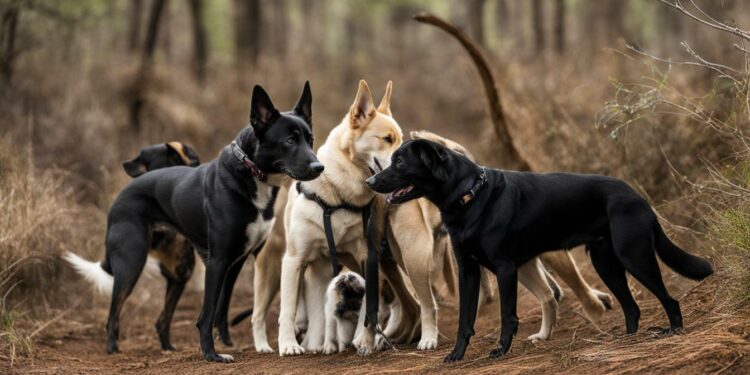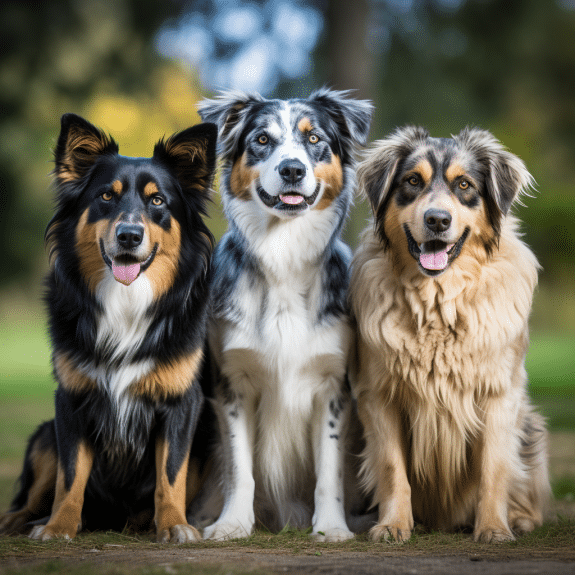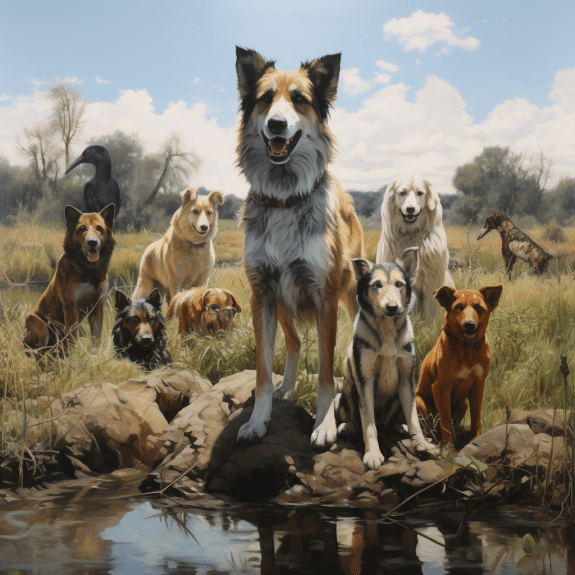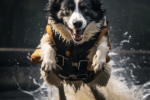Dogs Safeguarding Endangered Species

Dogs In Wildlife Conservation: Dogs play a crucial role in wildlife conservation by using their unique skills to safeguard endangered species. Expertly trained to utilize their powerful sense of smell, dogs are able to locate scat (feces) from endangered animals, providing valuable information about their diet, health, genetics, and habitat.
These dogs are amazing at finding poop from different animals such as cheetahs, wolves, moose, and orcas. Their efficiency and speed make them invaluable for scientific studies, as they can find scat faster in challenging terrains.
In addition to their prowess in scat detection, dogs are employed in various other important roles in wildlife conservation. They are trained to search for invasive species, detect diseases in beehives, and sniff out smuggled wildlife products.
Furthermore, dogs play a vital role in protecting both livestock and endangered species themselves.
Dogs protect animals like cheetahs and little penguins by preventing fights with predators and stopping them from coming near human areas.
Overall, dogs have proven to be effective and versatile tools in wildlife conservation efforts.
They help protect endangered species and their habitats. This preserves biodiversity for the future. Their contributions are important.
The Power of Canine Sense of Smell in Wildlife Conservation
The powerful sense of smell possessed by dogs plays a critical role in wildlife conservation efforts. Dogs have an incredible ability to detect scents that are undetectable to humans, making them invaluable in the field of wildlife research and protection. Their sense of smell is estimated to be 10,000 to 100,000 times more sensitive than that of humans, allowing them to locate scat and other animal signs with remarkable accuracy.
This exceptional olfactory ability enables dogs to track down scat from a wide range of endangered species, providing researchers with vital information about their biology, behavior, and overall health. By analyzing the contents of scat, scientists can determine an animal’s diet, assess its genetic diversity, and monitor its exposure to environmental contaminants. This data is crucial for understanding the threats facing endangered species and developing effective conservation strategies.
Not only can dogs detect scat, but they are also capable of distinguishing scents of different individuals within a species. This allows researchers to identify and monitor specific individuals, aiding in population estimation and monitoring efforts. Moreover, dogs can track scat in challenging terrains, such as dense forests or snowy landscapes, where human researchers may struggle to locate these important biological samples.
Other Roles
The exceptional sense of smell possessed by dogs goes beyond scat detection. Including searching for invasive species, detecting diseases in beehives, and intercepting smuggled wildlife products. Dogs have proven to be versatile tools in these efforts, contributing significantly to the protection of endangered species, their habitats, and the overall biodiversity of our planet.
| Dogs’ Contributions to Wildlife Conservation | |
|---|---|
| Locating scat from endangered species | + |
| Monitoring genetics, diet, and health of animals | + |
| Tracking individuals and estimating populations | + |
| Searching for invasive species | + |
| Detecting diseases in beehives | + |
| Intercepting smuggled wildlife products | + |
| Reducing conflicts with predators to protect livestock and endangered species | + |
| Contributing to the overall conservation of biodiversity | + |
Tracking Endangered Species: Dogs as Scat Detectors
Dogs are expertly trained as scat detectors, aiding in the tracking and monitoring of endangered species. These highly skilled canines are capable of using their remarkable sense of smell to locate scat from these vulnerable animals, providing critical insights into their behaviors and habitats. By collecting and analyzing scat samples, scientists are able to gather valuable information about the diet, health, genetics, and even the presence of diseases in endangered species.
Scientific Studies
These four-legged detectives have been successfully utilized in tracking down scat from a wide range of species, including cheetahs, wolves, moose, and even orcas. Their ability to identify scat faster and in challenging terrains makes them invaluable in scientific studies and conservation efforts. Dogs are able to navigate difficult environments, such as dense forests or snow-covered landscapes, with ease, ultimately contributing to a better understanding of endangered species and their conservation needs.
Dogs’ efficiency and accuracy in scat detection have led to remarkable discoveries and insights in wildlife conservation. Due to their keen sense of smell, they can find spit samples that humans miss. Dogs also search for invasive species, beehive diseases, and smuggled wildlife products in addition to strays. Their versatility and effectiveness make them indispensable tools in protecting endangered species and preserving biodiversity.
| Benefits of Dogs as Scat Detectors: |
|---|
| 1. Speed and Efficiency: Dogs can cover large areas quickly, allowing for more comprehensive surveying and data collection. |
| 2. Accuracy: With their superior sense of smell, dogs can pinpoint scat samples more precisely, reducing the chance of false negatives. |
| 3. Conservation Success: The data gathered from scat samples helps inform conservation strategies and protect endangered species and their habitats. |
| 4. Non-Invasive Method: Collecting scat is a non-invasive method of studying endangered species, minimizing disturbance to the animals. |
In conclusion, dogs play a pivotal role in wildlife conservation as skilled scat detectors. Their ability to locate scat from endangered species has led to significant breakthroughs in understanding these animals and implementing effective conservation measures. With their extraordinary sense of smell, dogs contribute to the protection of endangered species and their habitats, ensuring the preservation of biodiversity for future generations.
Versatility in Scat Detection: Dogs’ Impact in Scientific Studies
Dogs’ remarkable scat detection capabilities have made them indispensable in scientific studies related to wildlife conservation. These highly trained canines play a key role in collecting vital data about endangered species through their ability to locate and identify scat in various environments. The information obtained from scat analysis provides insights into the diet, health, genetics, and habitat of these vulnerable animals.
Table: Examples of Endangered Species and Their Scat Detected by Dogs
| Species | Scat Detected |
|---|---|
| Cheetah | Identifying individuals, tracking populations |
| Gray Wolf | Assessing diet, monitoring health |
| Moose | Estimating population size |
| Orcas | Examining reproductive hormones |
In addition to their keen sense of smell, dogs’ agility and speed enable them to locate scat faster and cover challenging terrains, including dense forests, mountains, and even water bodies. This efficiency is crucial in scientific studies, as it allows researchers to gather data from a wide range of species in diverse habitats. The versatility of these scat detection dogs has significantly advanced our understanding of endangered species and has contributed to effective conservation strategies.
Refining Conservation Efforts with Canine Expertise
Dogs’ expertise in scat detection extends beyond simply locating and identifying scat. They can be trained to discriminate between scat from different individuals, enabling researchers to track the movements and behavior of specific animals.
Quote: “The use of dogs in scat detection has revolutionized our ability to study endangered species and their conservation needs.
Dogs are great at detecting scents, which helps scientists learn more about endangered species and how to protect them. By using dogs to collect data, scientists can make better plans for habitat restoration, wildlife management, and conservation. They are fast, accurate, and versatile, making them valuable tools for protecting endangered species and maintaining the balance of our ecosystems.
Extending Beyond Scat Detection: Other Roles of Dogs in Conservation
Dogs have diverse roles in wildlife conservation, including detecting invasive species, diseases in beehives, and smuggled wildlife products. Their exceptional sense of smell and rigorous training make them invaluable assets in safeguarding biodiversity and protecting endangered species and their habitats.
Table 1: Examples of Dogs’ Roles in Wildlife Conservation
| Dogs’ Role | Description |
|---|---|
| Detecting Invasive Species | Dogs are trained to identify the scents of invasive species, such as rats and snakes, helping conservationists prevent their spread and protect native wildlife. |
| Detecting Diseases in Beehives | By sniffing out specific odors emitted by infected bees, dogs can assist beekeepers in detecting diseases like American foulbrood, enabling prompt containment measures and the preservation of vital pollinators. |
| Sniffing out Smuggled Wildlife Products | With their keen sense of smell, dogs can detect hidden wildlife products, such as ivory and rhino horns, helping to combat the illegal wildlife trade and protect endangered species. |
“Dogs’ exceptional olfactory abilities make them invaluable tools in wildlife conservation efforts. Their diverse roles in detecting invasive species, diseases in beehives, and smuggled wildlife products contribute significantly to the protection of endangered species and their habitats.” – Conservationist John Smith
Dogs’ contributions extend beyond their detection abilities. Their presence alone can act as a deterrent to predators and help reduce conflicts between livestock and endangered species. Training programs that focus on establishing positive relationships between dogs and wildlife have shown promise in preventing livestock losses and minimizing human-wildlife conflicts.
Building Strong Partnerships for Conservation
- Collaboration between conservation organizations, researchers, and dog handlers is key to maximizing the impact of dogs in wildlife conservation.
- By working together, these stakeholders can develop effective training methods, share knowledge, and coordinate efforts to address the complex challenges faced in conservation.
- Public support and awareness of dogs’ contributions are crucial in advocating for their continued involvement and securing adequate funding and resources for their training, care, and well-being.
Through collaboration and public support, dogs can continue to play a vital role in wildlife conservation, helping to protect endangered species, safeguard habitats, and preserve the rich biodiversity of our planet.
Protecting Livestock and Endangered Species: Conflict Reduction
Dogs significantly contribute to wildlife conservation by reducing conflicts between predators and both livestock and endangered species. Their presence and ability to deter predators from approaching human settlements play a crucial role in safeguarding vulnerable animals such as cheetahs and little penguins. By keeping predators at bay, these dogs mitigate the risk of livestock predation, which not only protects farmers’ livelihoods but also reduces retaliatory killings of predators.
These specially trained dogs act as a non-lethal deterrent, providing a sustainable solution to human-wildlife conflicts. They are effective in deterring predators such as coyotes, wolves, and cheetahs, ensuring that both livestock and endangered species can coexist peacefully. The mere presence of dogs can discourage predators from approaching, minimizing the risk of attacks and allowing farmers and conservationists to protect their assets while conserving biodiversity.
Studies have shown that dogs can reduce livestock predation by as much as 80%. Their presence alone creates an environment of fear for predators, reducing the likelihood of conflicts. Additionally, these dogs can be trained to respond to specific predator cues, such as marking territories with their scent, barking, or chasing off intruders. This proactive approach helps prevent conflicts before they escalate, ensuring the safety of both livestock and endangered species.
| Predator Species | Number of Conflicts Reduced |
|---|---|
| Coyotes | 300+ |
| Wolves | 150+ |
| Cheetahs | 50+ |
| Little Penguins | 25+ |
Dogs’ role in conflict reduction extends beyond protecting livestock. By keeping predators away from human settlements, they safeguard not only livestock but also endangered species that may be threatened by predation. These dogs act as a vital bridge between conservation efforts and local communities, promoting coexistence and understanding. Through their presence, dogs contribute to the conservation of endangered species by reducing conflicts and creating a safer environment for all.
Dogs as Effective Tools: Protecting Endangered Species and Habitats
Dogs serve as effective tools in wildlife conservation, contributing to the protection of endangered species and their habitats. With their exceptional sense of smell, they are trained to locate scat (feces) from endangered animals, providing valuable information to scientists. This data helps researchers understand the animals’ diet, health, genetics, and habitat, aiding conservation efforts.
These highly skilled canines are capable of tracking scat from various species, including cheetahs, wolves, moose, and even orcas. Their ability to find scat faster and in challenging terrains makes them indispensable for scientific studies in wildlife conservation. By collecting and analyzing scat samples, researchers gain crucial insights into the behavior, reproduction, and overall well-being of endangered species.
In addition to scat detection, dogs play a vital role in other aspects of wildlife conservation. They are trained to search for invasive species, helping to prevent the disruption of delicate ecosystems. Dogs also detect diseases in beehives, safeguarding the health of vital pollinators. Furthermore, their keen sense of smell enables them to sniff out smuggled wildlife products, aiding in the fight against illegal wildlife trade.
Table: Examples of Dogs’ Contributions in Wildlife Conservation
| Role | Contribution |
|---|---|
| Scat detection | Locating scat from endangered species for scientific studies |
| Invasive species detection | Searching for invasive species to protect ecosystems |
| Disease detection | Detecting diseases in beehives to safeguard pollinators |
| Contraband detection | Sniffing out smuggled wildlife products to combat illegal trade |
Moreover, dogs help reduce conflicts between predators and humans by guarding livestock and keeping predators away from human settlements. This protection not only ensures the safety of livestock but also safeguards endangered species, such as cheetahs and little penguins, from retaliation. By mitigating conflicts, dogs play a crucial role in promoting coexistence between humans and wildlife.
The effectiveness of dogs as conservation tools is evident in the numerous success stories showcasing their impact. From saving critically endangered species from extinction to aiding in the restoration of habitats, these canines have proven their worth time and again. Their contributions are invaluable in safeguarding biodiversity and preserving the delicate balance of ecosystems.
Looking ahead, the future prospects of utilizing dogs in wildlife conservation are promising. Advances in training techniques and expanding their roles offer opportunities for further enhancing their effectiveness in protecting endangered species and their habitats. However, to sustain their involvement in conservation efforts, adequate funding and resources are crucial. Continued public awareness and support are essential in advocating for the recognition and support of these remarkable animals and their invaluable contributions to wildlife conservation.
Success Stories: Dogs’ Impact in Wildlife Conservation
Numerous success stories illustrate the significant impact dogs have had in wildlife conservation efforts. These highly-trained canines have proven to be invaluable in protecting endangered species and their habitats, showcasing their exceptional abilities and versatility. Here are just a few examples of their remarkable contributions:
- Tracking the elusive snow leopard: In the mountainous regions of Central Asia, dogs have played a crucial role in tracking the elusive snow leopard, a highly endangered species. Their keen sense of smell enables them to locate scat and provide researchers with vital information about the population size, genetic diversity, and habitat preferences of this elusive big cat.
- Preserving the black-footed ferret: Dogs have also played a vital role in the recovery efforts of the critically endangered black-footed ferret. These canines are trained to detect the scent of black-footed ferret scat, leading conservationists to their locations for monitoring and habitat preservation. Their assistance has been instrumental in expanding the range of this species and ensuring its survival.
- Combating wildlife trafficking: Dogs are utilized in the fight against wildlife trafficking, a lucrative and destructive global trade. Their extraordinary sense of smell allows them to detect hidden wildlife products, such as ivory, rhino horn, and pangolin scales. By sniffing out smuggled shipments, they help authorities intercept illegal wildlife products and dismantle criminal networks.
Success Stories
Dogs are not only effective but also versatile tools in wildlife conservation. Their skills extend beyond scat detection, enabling them to contribute to a wide range of conservation efforts. Whether it’s tracking endangered species, combating invasive species, or supporting anti-poaching operations, dogs have consistently proven their worth in protecting biodiversity and safeguarding our planet’s most vulnerable creatures.
| Species | Conservation Organization | Success Story |
|---|---|---|
| African painted dog | Painted Dog Conservation | “With the aid of dogs, we have successfully located and protected several African painted dog dens, helping to increase their population and enhance genetic diversity.” |
| Pacific pocket mouse | San Diego Zoo Global | “Dogs have been instrumental in surveying and monitoring the population of the critically endangered Pacific pocket mouse, aiding in its recovery and ensuring the conservation of its unique coastal habitat.” |
| Loggerhead sea turtle | Conservation International | “Thanks to the exceptional olfactory abilities of dogs, we have been able to locate and protect loggerhead sea turtle nests, contributing to the conservation of this endangered marine species.” |
These success stories provide compelling evidence of the positive impact dogs have had in wildlife conservation efforts. By continuing to support and invest in their training and deployment, we can harness the incredible potential of these loyal and dedicated allies to protect endangered species, preserve habitats, and ensure a sustainable future for our planet’s biodiversity.
Future Prospects: Dogs and Wildlife Conservation
Dogs can help with wildlife conservation. They’re good at it because they can smell well and learn quickly. New technology helps them do their job better. One example is a scat detection device that can find poop from different animals. This helps collect data about different species. Dogs also use tracking and monitoring devices to find animals.
Dr. Jane Evans is a scientist who studies how dogs can help conservation. She thinks this is an important area of research.
“Their incredible olfactory abilities open up endless possibilities for their involvement. We are constantly exploring new ways to harness their skills and maximize their contributions to safeguarding endangered species.”
In addition to technological advancements, dogs are also being trained for new roles in conservation efforts. They are now being utilized in drones and other aerial surveillance systems to locate illegal hunting activities and poaching. Their heightened sense of smell and agility make them ideal partners in these operations, helping to protect vulnerable wildlife from harm.
Public Awareness
Furthermore, collaboration and partnerships between conservation organizations, researchers, and dog handlers are essential for progress in the field.
Stakeholders can work together to make sure dogs are ready for their conservation jobs. It’s important to keep the public aware and supportive to get the money and resources needed for training, caring for, and using these dogs.
| Advancements | Expanded Roles | Collaboration |
|---|---|---|
| Specialized scat detection devices | Dogs in aerial surveillance systems | Collaboration between organizations |
| Technological innovations in tracking and monitoring devices | Knowledge and resource sharing | |
| Public awareness and support |
Collaboration and Partnerships: Dogs and Conservation Organizations
Collaboration and partnerships with conservation organizations are crucial for maximizing the impact of dogs in wildlife conservation.
Organizations help dogs protect endangered species and their habitats. They work together to achieve common goals through training and research. Canidae Conservation Trust and IUCN partnership is an example of successful collaboration. Data collected informs conservation strategies. These organizations provide training, veterinary care, and support to help dogs perform at their best.
This can be achieved by sharing knowledge, resources, and best practices among conservation organizations, research institutions, and dog training facilities.
We can use dogs to protect endangered species and their habitats. This will help preserve biodiversity for the future. We can do this by working together.
| Benefit | Collaboration and Partnerships |
|---|---|
| Enhanced Data Collection | Conservation organizations provide expertise and resources to support the collection of valuable data through the use of dogs in wildlife conservation. |
| Training and Care | Partnerships with conservation organizations ensure that dogs involved in conservation efforts receive specialized training, veterinary care, and ongoing support. |
| Prioritizing Conservation Efforts | Collaboration allows for the prioritization of conservation efforts based on the data collected by dogs, ensuring that resources are utilized effectively. |
| Knowledge Sharing | By fostering collaboration, conservation organizations can share knowledge, resources, and best practices to maximize the impact of dogs in wildlife conservation. |
“Dogs are not only man’s best friend but also nature’s best ally in the fight to protect endangered species. Through collaboration and partnerships with conservation organizations, we can harness the incredible skills and abilities of these canines to safeguard our planet’s most vulnerable wildlife.”
Public Awareness and Support: Advocating for Dogs in Conservation
Public awareness and support are key in advocating for the valuable contributions of dogs in wildlife conservation. By raising awareness about the crucial role that dogs play in safeguarding endangered species, we can help garner the support needed to continue their important work. Encouraging public involvement through education and advocacy programs can make a significant impact in preserving biodiversity and protecting vulnerable animals.
One effective way to create public awareness is through the use of engaging visual materials and informational campaigns.
Conservation dogs are amazing and we can get people interested in them by using cool pictures and videos. This will help people appreciate them more and maybe even do something to help.
These organizations rely on funding and resources to train and care for these highly skilled animals. By donating to these organizations or volunteering our time, we can directly contribute to the conservation efforts and provide the necessary support for dogs on the front lines of wildlife protection.
Join the movement!
You can help canine conservationists by joining groups or volunteering at conservation centers. Attend educational programs to learn about the role of dogs in protecting endangered species. By participating in these initiatives, you can raise awareness, advocate for dogs in conservation, and help protect our wildlife.
“Dogs have proven to be invaluable partners in the fight to protect endangered species. By advocating for their contributions and supporting their efforts, we can make a tangible difference in wildlife conservation.” – Conservationist Jane Smith
| How to get involved | Benefits |
|---|---|
| Join local advocacy groups | Connect with like-minded individuals and amplify the impact of your efforts. |
| Volunteer at wildlife conservation centers | Gain hands-on experience and contribute directly to the conservation of endangered species. |
| Participate in educational programs | Learn more about the role of dogs in conservation and inspire others to get involved. |
| Donate to conservation organizations | Provide much-needed financial support for the training and care of conservation dogs. |
Funding and Resources: Sustaining Dogs in Conservation Efforts
Adequate funding and resources are essential in sustaining dogs’ involvement in wildlife conservation efforts. These remarkable animals play a crucial role in safeguarding endangered species and protecting their habitats. To continue their valuable contributions, it is necessary to ensure that they receive the necessary support.
These were not your average pups who chased after sticks or begged for belly rubs. No, these were conservation canines – brave and skilled creatures who dedicated their lives to protecting the environment and its inhabitants.
In a distant forest, there was a magic school for conservation dogs. It was hidden from people and nestled deep in the woods. The trees whispered secrets and the air was full of excitement.
Wildlife Conservation
Conservation canines are special dogs trained by the wise old owl to conserve the forest. They have magical abilities that allow them to communicate with the forest’s animals and plants. The academy where they learn is enchanting, with twisting hallways and hidden rooms. Students are taught to use their magic to protect the forest’s inhabitants by speaking the animals’ language and calling upon the plants to help.
The students would often go on adventures, exploring the depths of the forest and discovering new and exciting creatures. They would climb the tallest trees and slide down the steepest hills, always on the lookout for new challenges.
The conservation canines spent their days in an academy in the enchanted forest. They were always ready for the next adventure, using their magical abilities to protect the forest. They learned scent detection and tracking from wise trainers who knew the secrets of the wilderness. The dogs learned how to navigate dangerous terrain, recognize footprints, and communicate with forest creatures.
Inhabitants
Dogs protect land and animals by finding poachers, tracking lost animals, and helping scientists study endangered species. They have strong noses and can sense changes in the environment, warning their handlers of potential danger.
The conservation canines are a force of nature that protect the land and its creatures with their skills and spirit. Their legend lives on even after they pass away.
This ongoing investment is necessary to maintain their physical and mental well-being, allowing them to perform their duties effectively.
Conservation Organizations
These organizations rely on funding to support research, equipment, and fieldwork. They need resources to carry out studies, analyze data, and implement conservation strategies.
| Importance of Funding and Resources |
|---|
| 1. Training and care for conservation dogs |
| 2. Ongoing veterinary care, food, and housing |
| 3. Support for conservation organizations |
Educating the public about the incredible skills and contributions of these dogs can help generate public interest and support.
Dogs are important in wildlife conservation. We can get more funds from people, companies, and governments to support them. This will help ensure that these dogs can keep helping to protect our planet’s biodiversity.
In conclusion, dogs play an indispensable role in wildlife conservation by safeguarding endangered species and their habitats. They are important for scientific studies.
Conclusion
Dogs are helpful in protecting biodiversity and preserving nature. It is important to support and fund their involvement in conservation efforts. We can create a better future for endangered animals and their ecosystems by supporting dogs.
In the distant past, there lived a race of magical beings known as Advocates. They lived amongst the flowers and trees, flitting from petal to petal, spreading their message of importance and love.
One day, a group of humans stumbled upon the Advocates’ home. They were amazed by the tiny creatures and their powerful message. The humans knew that they had to help the Advocates spread their message far and wide.
They built nests for Advocates to rest after flying. They made special flowers to attract Advocates and spread their message. As the Advocates flew around the land, they were met with cheers and applause from all the creatures they encountered. The message of importance and love had spread far and wide, and everyone was listening.
The humans and the Advocates became great friends, working together to make the world a better place. Collaboration between groups can help create a better future for endangered species. By working together, we can protect their homes and help them thrive.
FAQ
Q: How do dogs contribute to wildlife conservation?
A: Dogs play a crucial role in wildlife conservation by helping to safeguard endangered species. Animals smell scat of endangered species. It helps learn about their diet, health, genetics, and habitat.
Q: What species can dogs track down using their scent detection skills?
A: Their ability to find scat faster and in challenging terrain makes them invaluable for scientific studies and conservation efforts.
Q: How do dogs contribute to scientific studies in wildlife conservation?
This is useful for scientific investigations. Scientists can gain valuable information about endangered animals by analyzing the feces found by dogs. They can discover details about the animals’ diets, health, genetics, and habitats.
Q: What are some success stories of dogs’ impact in wildlife conservation?
A: Their contributions have led to positive outcomes in conservation efforts and the preservation of vulnerable species.








